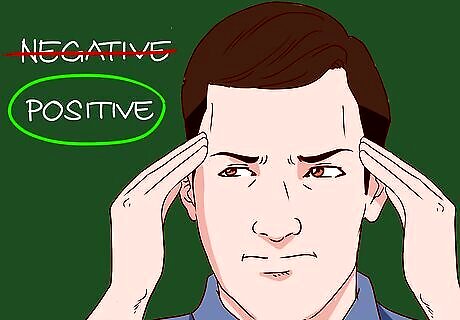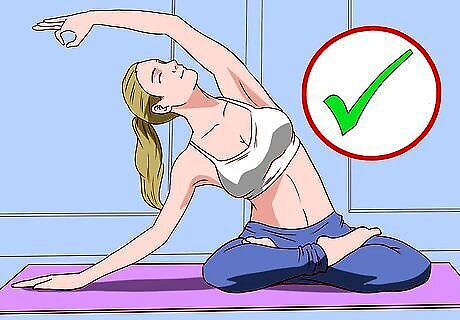
views
Calming Yourself in the Moment

Count to 10. When you start feeling upset, take a break and count to 10. As you count, imagine that with each number, you're reaching a new level of calmness. Taking the time to count to 10 will give your mind some distance from what you’re feeling, and it will help you respond less emotionally. If you still feel tense after counting to 10, try counting backwards from 10 to 1. Sometimes you’ll need even more time to calm down. In this case, try counting backwards from 100. You can do this counting exercise anywhere: at home, in the bathroom, in the elevator, or anywhere you are when you feel negative thoughts and frustrations come up.

Do breathing exercises to immediately relax. When you're stressed, your body goes into what's known as "fight or flight" mode. Your sympathetic nervous system accelerates your heart rate, tenses your muscles, and prepares your body to face an attack. Counteract this reaction by finding a place where you can be alone for at least 10 minutes to focus on your breath. Breathe deeply and evenly during this time in order to oxygenate your brain, slow your heart rate, and eventually gain control of your emotions. Breathe while counting to 10. Inhale on the even numbers and exhale on the odd numbers. You can even add an easy visualization by imagining you are breathing in a color that relaxes you, like blue or green. When you exhale, imagine a grey plume of smoke that represents your negative thoughts or emotions leaving your body. Sit comfortably with your hands on your belly. Breathe deeply into your belly and exhale fully from your belly. Allow your awareness to go to places in your body that feel tense. For example, many people hold tension in their necks, shoulders, knees, lower backs, or arms and hands. Breathe into the places in your body where you feel tension and allow the tension to melt away as you exhale. It might help to play some relaxing music while you do these exercises.

Remove yourself from an upsetting situation. If it is a conflict that involves other people, take a few breaths, explain quickly that you are upset (without going into details), and walk away. The goal is to give yourself some space, so you can deal with your emotions. This approach also gives you more control over your situation because you’ll have time to decide how to respond. Avoid storming off if you're upset since that can cause communication breakdown between you and others. Instead, say something like, "I'm feeling really upset right now and need to take a break. I'm going to take a short walk." Try going for as long of a walk as you need. Imagine that with each step you're letting your frustrations flow right down through your feet. Try to find a park or green space to walk in. Give yourself a break from thinking about what made you upset.

Acknowledge your thoughts. Pay attention to the negative thoughts that you’re experiencing and accept that you're upset. Being upset is not stupid or petty; it is a natural human emotion that everyone will experience from time to time. Everyone has the right to become upset, and every time we get upset, it's an opportunity for us to learn about what triggers strong emotional reactions in us. It may seem difficult or even corny at first but try talking to yourself to practice acknowledging your emotions. Say something like, "I'm feeling really upset right now. That is okay. I can control how I respond to these feelings." Consider writing down your thoughts when you're upset. Writing thoughts down in the moment will help you examine them later when you’re in a calmer state of mind.

Make yourself laugh to improve your mood. Find a picture of something funny on your phone or on the internet. Or think of a joke that always makes you laugh. Getting upset is a normal emotion, and like all emotions, it can be managed. If you use humor to give your mind a break from feeling upset or trying to resolve a conflict, you’ll be able to address it later when you have a clearer head. Laughing is not an attempt to minimize what you're upset about. It’s just a strategy to help control how you are feeling and how you respond to those feelings. Make sure that the humor you use is not mean-spirited or sarcastic. Those kinds of humor can actually make you feel more upset.

Listen to calming music. Take time to let whatever kind of music calms you down wash over you while you breathe and relax. If you feel like it, you can also dance or sing. Being physical and creative can also help you calm your body and connect with your feelings. This way, you're in a better position to deal with whatever's upsetting you. Look for music with about 60 beats per minute, which can help your brain synchronize your heartbeat with the beat of the music. This may induce a calm, relaxed state. Classical music, light jazz, "easy listening," or New Age artists such as Enya may be particularly helpful. You can find several websites that supply your mobile phone with calming music. This way, you can easily calm yourself down. The most important thing is that you enjoy the music you play. While it's popular to claim that listening to angry music makes you angrier, research has not found a clear connection between these things. So if you enjoy "extreme" music, it may also help you control your emotions when you're angry or upset.

Change your language. Reframe the negative thoughts you’re having into positive statements. This approach can help you think about the situation differently, which can help improve your mood. Practice using positive language to help keep yourself calm. For example, if you are upset about having accidentally broken something, you may think things like: "Nothing ever goes right for me." Or, "Everything always gets messed up." These are examples of all-or-nothing thinking, a common "thought trap." Instead, try to reframe your thoughts to statements like, "It was just an accident. Accidents happen all the time." Or, "Everybody makes mistakes. It doesn’t mean I need to get upset." You may also become upset if you jump to conclusions about others or "personalize" situations, making them about you when they aren't. For example, if someone cuts you off in traffic, you may get angry and believe that person intentionally harmed you. This is personalization. If this happens, reframe the situation: the driver probably didn’t see you or is new to driving. There are many explanations other than a personal attack. It's important to remember this since feeling personally injured or attacked is a common cause of anger.

Do something physical to release tension. You can calm your mind through physical activity. Exercise releases endorphins, which are natural chemicals that boost your mood. Moderate exercise can relieve stress and anxiety. Go for a run, take a trip to the gym, or punch a punching bag. Less intense activities like gentle stretching or walking work well too. Stretching increases blood flow throughout the body, which can help release tense muscles. It can also leave you feeling refreshed and relaxed. Some people find a cleaning project calming because it’s physical, shows immediate results, and can help distract your mind by doing something proactive and useful. Clutter may also increase feelings of stress, so reducing clutter may help you feel more calm and relaxed.
Creating a Calm Mindset

Recognize that you cannot control others. The only person you can fully control is yourself. While you cannot completely shield or insulate yourself from the upsetting actions of others, you can nurture yourself and build a buffer against daily frustrations and situations. For example, you can't control irresponsible drivers, annoying peers, or conflicts in relationships. But you can control how you respond to the irritations. Try taking time to pamper yourself by giving yourself time to read a great book, taking a calming bath, or giving yourself time to go on a long walk in your neighborhood.

Try the RAIN practice. RAIN is an acronym that can help you practice mindfulness in your daily life. Many research studies have shown that mindfulness practice can help relieve stress. Recognize the experience. Acknowledge what is happening at the present moment. Notice how you feel, what your body is experiencing, and what you're thinking. Allow yourself to feel these things. When you encounter thoughts and feelings brought up by an experience, allow yourself to feel them. Too often, we try to repress our emotions, which can end up making us more stressed and upset. Acknowledge that your emotions exist, and that they are neither "right" nor "wrong" -- they simply are. Investigate the situation with kindness. Show yourself the same compassion you would show to a friend. For example, if you are feeling stressed out, you might feel that you are stupid or worthless. Investigate these thoughts. Would you say these things to a friend? Try showing yourself kindness instead by telling yourself something compassionate like "I am worthy." Natural loving awareness will arise when you practice the first three steps. This will allow you to detach from those generalizations like "I'm a loser" or "I'm stupid." You will realize that while those feelings may show up, they most likely appear because of a fear or insecurity.

Practice meditation. Studies have shown that meditation can literally rewire how your brain responds to stressors. This is especially true for mindfulness meditation, which has been widely studied. You don't have to meditate for hours to see a benefit. Even taking 15 minutes a day to meditate can help you become calmer. For example, some people find it helpful to meditate as soon as they wake up in the morning. This way, you are already calm and sleepy. Just hit the snooze on your alarm, sit up, and focus on your breathing. Daily meditation can help lower your stress response, make it easier to let go of smaller frustrations, and create a calmer mindset when dealing with conflicts of any kind.

Do yoga. Yoga has been clinically shown to help relieve stress, anxiety, and depression. Most forms of yoga incorporate meditation, breathwork, and gentle movement, making it a great technique to help you calm down and quell those stress responses. Since there are many forms of yoga, find a class that suits your abilities and is taught by someone you're comfortable with. You should do yoga in a calm environment that relaxes you. Relax your mind by connecting yourself to your emotions and body. Remember that yoga is not about getting into peak physical fitness, nor is it a competition. Check out wikiHow's wide selection of Yoga articles for further information.

Pay attention to your daily emotions. Consider what you're feeling and going through. Respect these feelings, which will help you respond calmly to things that distress you. You may want to write your emotions in a journal. Journaling about your emotions may help you reduce stress and manage feelings of anxiety and depression. Exploring your feelings can help you feel calmer and more empowered to deal with daily challenges because you’ll know that you have ways to deal with your feelings. Remember to use self-compassion when journaling. Studies suggest that simply writing about your negative feelings or stress is insufficient to help you. You should also try to be kind to yourself about your feelings and find ways to brainstorm solutions. For example, if you found yourself feeling very angry with a coworker, write about that experience in your journal. What happened? How did you feel? How did you respond in the moment? Would you change anything about the way you responded? What can you do to avoid responding in this way in the future?
Making Calming Lifestyle Choices

Exercise to reduce stress. Try to get some physical exercise every day, even if it’s just a walk, or taking 20 minutes to have a dance party. Regular exercise can release endorphins, natural painkillers, which can relax you and regulate your mood. Inactivity can actually create tension and stress, making you more likely to overreact to situations that upset you.

Avoid caffeine and sugar. Both of these substances can make your adrenal glands increase the production of stress hormones, which makes it easier for you to get upset and harder to remain calm. Try cutting out caffeine and sugar for a few weeks to see if you feel calmer and more relaxed. Then, you can gradually add small amounts of caffeine or sugar, if you like. Even if you do decide to drink caffeine, make sure to consume no more than 400mg per day as an adult or 100mg per day as a teen. Try to eat a healthy snack every 3 to 4 hours. This helps keep your blood sugar constant, which can prevent mood swings and irritability.

Do not turn to alcohol to relieve stress. Although it is very common to use alcohol as a coping strategy for stress, this is not a healthy behavior. If you’re the legal age, it is usually okay to enjoy the occasional drink, but you should not use alcohol as "stress relief." This approach puts you at an increased risk of alcohol abuse and alcoholism. If you choose to drink alcohol, do so only in moderation. The National Institute on Alcohol Abuse and Alcoholism suggests that males drink no more than 4 drinks per day and no more than 14 drinks per week. Females should drink no more than 3 drinks per day and no more than 7 drinks per week. A single "drink" refers to 12 oz. of regular beer, 8-9 oz. of malt liquor, 5oz. of wine, or 1.5 oz. (a shot) of 80-proof liquor. Don't drink alcohol right before bed. Although it may make you feel drowsy at first, alcohol interferes with REM sleep and can leave you feeling fatigued the next day.

Make sure you get enough sleep. Insufficient sleep is a common cause of feeling stressed out and anxious. Studies suggest that most Americans need more sleep than they currently get. Take some steps to make sure the sleep you get is as good as it can be: Get into a pre-sleep routine. Avoid screens, such as the computer or TV, before bed. Have a cup of herbal tea or take a warm bath. Do the same thing each evening before bed. Avoid caffeine and nicotine before bed. These are stimulants and could keep you awake. Try to wake up and go to bed at the same time each day, even on weekends. This will help your body clock stay regular.

Establish a good balance between work and leisure. Make sure that you have things to look forward to, whether it’s a vacation, leisure time at home, a favorite TV show, or taking a class that interests you. You should feel as though your life is balanced between what you have to do and what you want to do. Knowing that you're caring for yourself in this way can create a sense of calmness and satisfaction. Both of these are buffers against getting upset and reacting negatively. Manage your time efficiently. A lot of people waste a lot of time during the day. Eliminate distractions so you’re productive when at work, school, or focusing on homework. By accomplishing what you have to do more efficiently, you’ll have more time to focus on the activities that help you relax. Set boundaries to help you manage your time. If you’re an adult, consider not answering any work emails when you’re at home. If you’re a student, try to finish your homework by a certain time every night. If texting and social media is keeping you from focusing on other things that make you happy, turn off your phone or computer at the same time every night and give yourself a break! Schedule time for fun. Particularly if you have a busy schedule, "me-time" may get pushed off your radar entirely. Try to schedule some relaxation time for yourself, even putting it into your calendar or agenda.




















Comments
0 comment